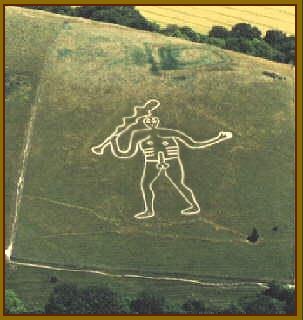
The Cerne Abbas Giant
This chalk carving can be found on a hillside at the village of Cerne Abbas, a little way to the north of Dorchester in Dorset.
Hillside carvings are relatively commonplace throughout the counties of Dorset, Wiltshire and Oxfordshire but the Cerne Abbas Giant is probably one of the most striking examples, (for obvious reasons!).
This carving is popularly believed to date from the Romano-British era, (around 0 - 400 CE) and is thought to be a representation of the God Hercules. It is possible that the carving is older still, possibly being a representation of the deity of a Celtic fertility cult. Alternatively it is possible that the carving is no more than 500 years old and I will discuss this possibility further down the page.
The gradient of the slope must not be underestimated. On a recent visit to the site I found the ascent of the hill exhausting and the descent truly terrifying!!
Above the Giant's head and slightly to the right is small rectiform earthwork known as the "Trendle" or "Frying Pan". Again the purpose of this earthwork is uncertain although it is widely accepted that a temple once stood here. For hundreds of years it was local custom to erect a maypole within the earthwork about which childless couples would dance to promote fertility.
It is possible that the carving of the giant was engineered by the inhabitants of nearby Maiden Castle but there is evidence to suggest that the carving is nowhere near as old as was previously thought. This evidence is well stated in Ronald Hutton's book, "The Pagan Religions of the Ancient British Isles...". Through his extensive research Mr Hutton has made reference to historical documents which mention the site at Cerne Abbas. Interestingly the site where the Giant can be found was always referred to as "Trendle Hill" not "Giant Hill" as it is known today. As I stated earlier the Trendle is the temple at the top of the hill. Why no mention of the Giant? Medieval writings talk of the various rituals carried out at the site but say nothing about the carving. This is doubly surprising when one considers that Cerne Abbas was the site of a Medieval abbey. Knowing as we do how well the monks of those times documented all around them this begs the question, did the Giant exist at all in medieval times? In fact the earliest reference to the Giant comes as late as 1742 and in 1751 a writer stated that the carving had only been made in the previous century. If this is to be beleived the Cerne Abbas giant is not a relic from prehistoric times at all but a sixteenth century hoax!